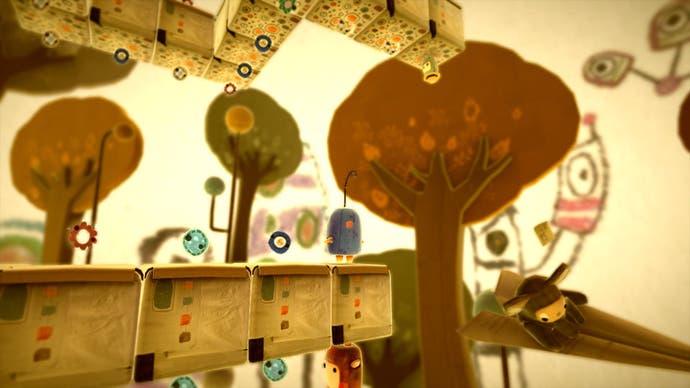ilomilo
You, me and the cubes.
Ignore the visuals and the soundtrack (a mix of nursery-rhyme melodies, ambient sounds and out-of-tune parping, like an arthouse take on In The Night Garden) and there would still be plenty to recommend here. The puzzles are thoughtfully constructed, controls work just fine, and the camera is flexible and helpful enough to slice a circular piece of the environment away if a cube is blocking your view of ilo or milo.
But it's the presentation which really impresses. ilo and milo themselves totter around adorably, and the environments are flat-out gorgeous. The park setting of the first chapter is suffused with the glow of a late summer's afternoon, as various structures and contraptions stretch into the sky in front of what looks like a child's painting of a tree. Marine levels are bathed in shades of green and blue, as strands of cloth seaweed – or are they tentacles? – undulate gently and strange undersea creatures swoop and dive around the cube structures in the centre.

The third chapter is an origami masterpiece as paper floats down from the sky in front of sheets of mathematical formulae and childish drawings. Finally, the last chapter immerses the player in an indigo twilight, as wonky spindles and foil stars sleepily spin, the environment softly illuminated by cubes of light. It's perhaps the most beautiful puzzle game you've ever seen, and an astonishingly rich world for an 800-point downloadable game.
A multiplayer option sweetens the deal, even if the game forces you to unlock stages afresh. When one player switches control to the other, they can control a fly which can highlight cubes for suggested moves, or bring up a pair of flat-cap-wearing musical puppets who bang a drum and play an out-of-tune tuba. It's a delightfully silly touch, as are the cameos from a couple of indie-game favourites.

One level on the third chapter hides 'ilomilo shuffle', a mini-game with an 8-bit visual style, while reaching the games' nonsense-spouting tutor Sebastian in the bonus stages sees him retell the fairytale of The Huntsman and the Fox. Even once you've seen everything, there's impetus to try each stage again with the minimum number of cubes traversed. Trying to reduce my pathetic tallies to somewhere approaching the community average is my next target.
There's just one small caveat at present: should you have 'helper bubbles' turned on in the game's settings, it has a tendency to freeze. In completing 32 of 36 stages and eight bonus levels, the game came crashing to a sudden halt on 10 occasions. This did tend to happen whenever I attempted something particularly stupid (like trying to pick up a Muncher; in my defence it was the first time I'd seen one) but it can also happen if you tap the A button to collect an elevator cube before it's come to a complete stop, for example. In a game where levels often take 15 minutes to complete, a freeze close to the end can be inordinately frustrating. As long as you ensure the bubbles are switched off in the settings – which they are by default – then you shouldn't suffer any freezes, although Southend is currently beavering away on a patch to resolve this minor issue.
Otherwise, this is a dreamily pretty and astonishingly compulsive puzzler that's a good deal more polished than many full-price retail releases. Its often bizarre sense of humour might not be to all tastes, but if the wackiness doesn't appeal, the visuals and the intelligently-constructed riddles surely will. If it weren't for a stunning recent remake of a certain arcade classic, you'd struggle to find a better way to spend 800 Microsoft points.
